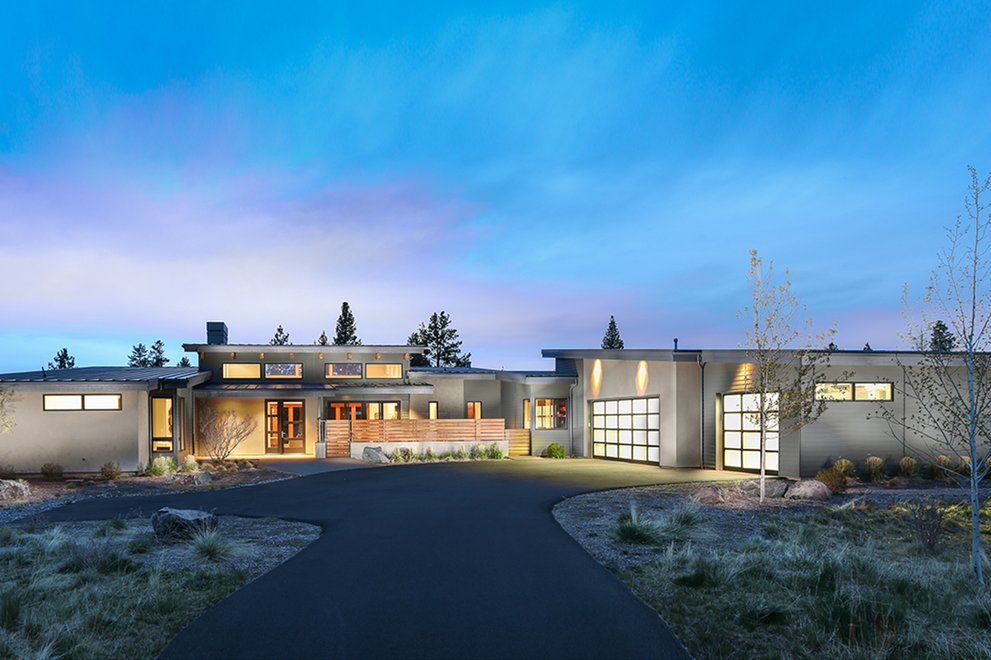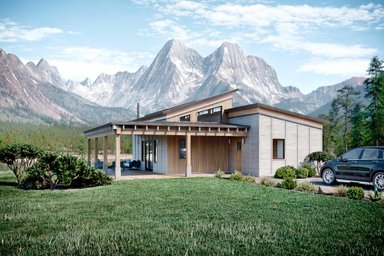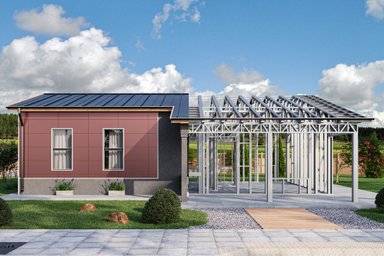[We asked contractor David Jacknin to interview internationally
acclaimed architect, David Hertz, FAIA, a pioneer in the field of sustainability,
whose book on resource efficient design, The Restorative Home, was published
last year. The most famous Hertz project so far, and the cover for his book, is the house he designed out of the wings from a decommissioned Boeing 747. His involvement with the novel Skywater system for drawing water out of the air was described in the July 18, 2016 New Yorker.– Ed.]
What are some of your ideas for lessening the impact of a house on the natural environment?
It starts with the idea that a house should give back more than it consumes. It is possible to build a house so that it produces more energy than it consumes, that takes advantage of natural ventilation, natural lighting and that even produces its own food and water.
Wow, so, how do we break that down to specific steps a homeowner can take?
Start by picking a building plan that works with your site and then orienting the house correctly in relation to the path of the sun. It’s also important to understand the prevailing breezes and how the house can be oriented to take advantage of them.
Above is David's dining room in Venice, California where large sliders allow it to become an extension of the courtyard. Recycled and FSC-certified ipe, mahogany, and fir are used throughout the house; the table and benches are made from scraps of wood leftover from making other parts of the house. The sideboard top in the background is his lightweight eco-concrete called Syndecrete.
In some of your articles you mention embodied energy. What is it and why is it important?
It is important for people to understand the concept of embodied energy. A material like aluminum, for example, requires a great deal of energy in its production. If a new building material has a large quantity of aluminum then it has a great deal of embodied energy. If, however, you repurpose aluminum that is already in the waste stream and reuse it, this is a big win for the environment. The same goes for other materials.
Repurposing has been a big part of many of your projects. Can you tell me more about this?
Again it’s about reducing the embodied energy. Our culture produces a great deal of waste both at the manufacturing level and then at the landfill level. By taking something out of the waste stream and using it in the production of a house, one is upcycling or giving the material a higher and better use. This can be done by using reclaimed flooring, lumber, doors, windows and hardware.
Your book talks about energy generation, what are some of the systems you have used?
We use PV Photo Voltaic panels to produce electricity and flat plate and parabolic tube collectors to heat water. Parabolic collectors are an efficient way to heat water in a small space. Heated water then supplies the radiant heating system embedded in the floors. We also employ passive techniques to heat the house. By orientating thermal masses towards the sun, the concrete absorbs energy during the day and releases it slowly at night.
What other techniques do you use to control temperature?
Many of our designs include a solar chimney which uses convection currents to exhaust and control heat. We also use thermostatically controlled skylights and windows to take advantage of natural ventilation and to control temperatures.
You’ve described your concrete product as a “contemporary terrazzo made from our waste stream.” Can you tell me more about that?
Syndecrete is half the weight of normal concrete with a much higher compression strength. It is
also made from 41% recycled materials, such as post consumer carpet fiber as reinforcement. Syndecrete is composed of a high volume of fly ash and uses materials extracted from the waste stream as decorative aggregates like recycled bottle glass, plastic regrind, electronic parts, etc. This is a good example of a way to make the house more resource efficient.
How about the claim that you make water out of air and your use of “living walls”?
I am very excited about my association with Skywater. Skywater is a patented atmospheric water generator
that makes water from air. With the Skywater system, homeowners can produce their own pure drinking water at home, even using solar energy. Our designs also include vegetative walls including aeroponic food towers that can grow a high volume of vegetables in a vertical space with a much lower volume of water. Such a system gives homeowners immediate access to organic food and helps create a sustainable and restorative environment.
What other steps are you taking to protect the environment?
We make sure the woods we use are FSC certified and are harvested in a sustainable way. We also pay attention to indoor air quality by using zero VOC paints and designing the house to maximize natural ventilation.
What about cost… this all sounds expensive?
By using repurposed and locally sourced materials houses often end up costing about the same amount per square foot as conventional construction methods. Operating costs are much lower as the houses produce their own energy.
How do you think your work can impact the larger building industry and the way people live?
I’m hoping that my work can help influence others to consider embodied energy, human connections to the natural world and our place in it.
All photos courtesy David Hertz, FAIA and the Studio of Environmental Architecture.
last year. The most famous Hertz project so far, and the cover for his book, is the house he designed out of the wings from a decommissioned Boeing 747. His involvement with the novel Skywater system for drawing water out of the air was described in the July 18, 2016 New Yorker.– Ed.]
What are some of your ideas for lessening the impact of a house on the natural environment?
It starts with the idea that a house should give back more than it consumes. It is possible to build a house so that it produces more energy than it consumes, that takes advantage of natural ventilation, natural lighting and that even produces its own food and water.
Wow, so, how do we break that down to specific steps a homeowner can take?
Start by picking a building plan that works with your site and then orienting the house correctly in relation to the path of the sun. It’s also important to understand the prevailing breezes and how the house can be oriented to take advantage of them.
Above is David's dining room in Venice, California where large sliders allow it to become an extension of the courtyard. Recycled and FSC-certified ipe, mahogany, and fir are used throughout the house; the table and benches are made from scraps of wood leftover from making other parts of the house. The sideboard top in the background is his lightweight eco-concrete called Syndecrete.
In some of your articles you mention embodied energy. What is it and why is it important?
It is important for people to understand the concept of embodied energy. A material like aluminum, for example, requires a great deal of energy in its production. If a new building material has a large quantity of aluminum then it has a great deal of embodied energy. If, however, you repurpose aluminum that is already in the waste stream and reuse it, this is a big win for the environment. The same goes for other materials.
Repurposing has been a big part of many of your projects. Can you tell me more about this?
Again it’s about reducing the embodied energy. Our culture produces a great deal of waste both at the manufacturing level and then at the landfill level. By taking something out of the waste stream and using it in the production of a house, one is upcycling or giving the material a higher and better use. This can be done by using reclaimed flooring, lumber, doors, windows and hardware.
Your book talks about energy generation, what are some of the systems you have used?
We use PV Photo Voltaic panels to produce electricity and flat plate and parabolic tube collectors to heat water. Parabolic collectors are an efficient way to heat water in a small space. Heated water then supplies the radiant heating system embedded in the floors. We also employ passive techniques to heat the house. By orientating thermal masses towards the sun, the concrete absorbs energy during the day and releases it slowly at night.
What other techniques do you use to control temperature?
Many of our designs include a solar chimney which uses convection currents to exhaust and control heat. We also use thermostatically controlled skylights and windows to take advantage of natural ventilation and to control temperatures.
You’ve described your concrete product as a “contemporary terrazzo made from our waste stream.” Can you tell me more about that?
Syndecrete is half the weight of normal concrete with a much higher compression strength. It is
also made from 41% recycled materials, such as post consumer carpet fiber as reinforcement. Syndecrete is composed of a high volume of fly ash and uses materials extracted from the waste stream as decorative aggregates like recycled bottle glass, plastic regrind, electronic parts, etc. This is a good example of a way to make the house more resource efficient.
How about the claim that you make water out of air and your use of “living walls”?
I am very excited about my association with Skywater. Skywater is a patented atmospheric water generator
that makes water from air. With the Skywater system, homeowners can produce their own pure drinking water at home, even using solar energy. Our designs also include vegetative walls including aeroponic food towers that can grow a high volume of vegetables in a vertical space with a much lower volume of water. Such a system gives homeowners immediate access to organic food and helps create a sustainable and restorative environment.
What other steps are you taking to protect the environment?
We make sure the woods we use are FSC certified and are harvested in a sustainable way. We also pay attention to indoor air quality by using zero VOC paints and designing the house to maximize natural ventilation.
What about cost… this all sounds expensive?
By using repurposed and locally sourced materials houses often end up costing about the same amount per square foot as conventional construction methods. Operating costs are much lower as the houses produce their own energy.
How do you think your work can impact the larger building industry and the way people live?
I’m hoping that my work can help influence others to consider embodied energy, human connections to the natural world and our place in it.
All photos courtesy David Hertz, FAIA and the Studio of Environmental Architecture.






